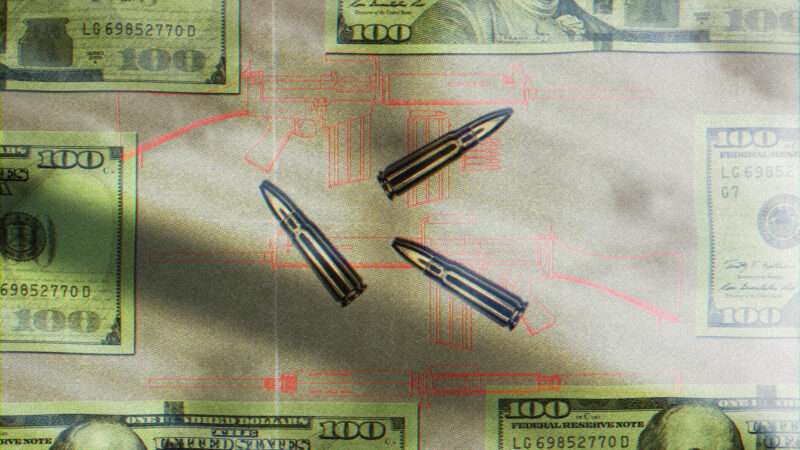
If you worry that one day armed federal agents might kick down your door, you probably assume that they would at least come from a law enforcement agency. But as it turns out, they might just be tax collectors.
That revelation comes from a newly updated report compiled by Open the Books, a government watchdog organization. It follows up on revelations first made by Open the Books founder and CEO Adam Andrzejewski in a 2016 Wall Street Journal op-ed.
The report alleges that since 2006, 103 federal agencies not contained within the Department of Defense (DOD) have collectively "spent $3.7 billion on guns, ammunition, and military-style equipment" (all numbers adjusted for inflation). Of those 103 agencies, 27 are "traditional law enforcement [entities] under the Department of Justice (DOJ) and the Department of Homeland Security (DHS)."
That leaves 76 agencies—including the Environmental Protection Agency (EPA), Internal Revenue Service (IRS), and the Department of Health and Human Services (HHS)—without a direct law enforcement purview. As the report put it, "There are now more federal agents with arrest and firearm authority (200,000) than U.S. Marines (186,000)."
The IRS in particular has spent $35.2 million on guns and ammo since 2006. Of that, according to a spreadsheet Andrzejewski provided to Reason, over $9.75 million has been spent just since 2020, including more than $2.2 million on ammunition, $474,000 on rifles, $463,000 on shotguns, and $1.17 million on ballistic shields, plus another $1.3 million on "various other gear for criminal investigation agents." According to a December 2018 report from the Government Accountability Office (GAO), in 2017–18, the agency had 4,461 guns and 5,047,300 rounds of ammunition in inventory.
The existence of armed IRS agents is not new information: Last year, the Inflation Reduction Act apportioned $80 billion in new funding for the agency, including $45.7 billion in "enforcement," estimated to support as many as 87,000 new hires. When some Republicans recoiled at the idea of tens of thousands of armed tax collectors, fact-checkers helpfully pointed out that only one division of the agency, IRS Criminal Investigation (IRS-CI), employs special agents who carry guns. IRS-CI has been around since 1919, charged with enforcing crimes like money laundering and narcotics trafficking. An IRS-CI spokesperson told Reuters that of the more than 81,600 IRS staff, only the 2,100 IRS-CI special agents carry guns.
PolitiFact further reported that while the IRS "did spend about $725,000 on ammunition" in 2022, "that is not unusual, and is actually a bit less than what was spent in other recent years."
But is that really a comforting statistic? Dividing $725,000 by 2,100 agents suggests that, on average, every single IRS special agent gets $345 in ammunition per year. And while PolitiFact notes that IRS-CI "famously investigated gangster Al Capone," each of the "top 10 cases of 2022" listed on its website consisted of nonviolent schemes like money laundering and fraudulently obtaining pandemic aid; its No. 1 case was the conviction of attorney Michael Avenatti for payroll tax fraud. It's not clear, in that context, why the IRS even needs its own gun-toting police force, much less why it needs rifles, shotguns, 5 million bullets, and more of each every year.
As Open the Books details, the IRS is not the only agency with a swelling stockpile: The HHS employs nearly 500 special agents, and since 2006, it has spent $154 million on "guns, ammunition, and military-style equipment." According to a spreadsheet that Andrzejewski provided to Reason, since 2020, the HHS has spent over $427,000 on "tactical combat gear," $247,000 on ammunition, $100,000 on "law enforcement weapons," and $99,450 on a "virtual reality weapons simulator," among other expenditures. This is all in addition to a $685,000 line item simply listed as "law enforcement equipment."
Why, exactly, does the federal agency, whose stated mission includes "fostering sound, sustained advances in the sciences underlying medicine, public health, and social services," spend so much on guns, ammo, and combat gear?
Partly, that total includes the National Institutes of Health's Division of Police, a 96-member police force that patrols NIH facilities around the country. But it also includes the HHS Office of the Inspector General (OIG), the agency's oversight authority that was tasked with protecting Anthony Fauci after he received death threats in 2020. At the time of the December 2018 GAO report, the HHS OIG had 1,061 pistols, 12 revolvers, two rifles, one shotgun, 194 "fully automatic firearms," and 929,461 rounds of ammunition.
Police militarization is a serious problem: Between 2006 and 2016, the federal government gave local police departments $2.2 billion worth of equipment intended for military use. During the 2014 protests in Ferguson, Missouri, the American public saw riot police deploying tear gas while riding in armored trucks that looked more suited for a war zone in the Middle East than a town in the Midwest.
So it's that much more troubling that not only are local police departments stocked with military-style weaponry, but federal administrative agencies are armed to the hilt as well. Andrzejewski told Reason in a statement, "A generation ago, there were clear distinctions between general administrative agencies and law enforcement agencies. Since we broke this story on the militarization of the federal agencies in 2016, the feds are continuing to blur the lines."
The post Why Do Federal Bureaucrats Need So Much Firepower? appeared first on Reason.com.







